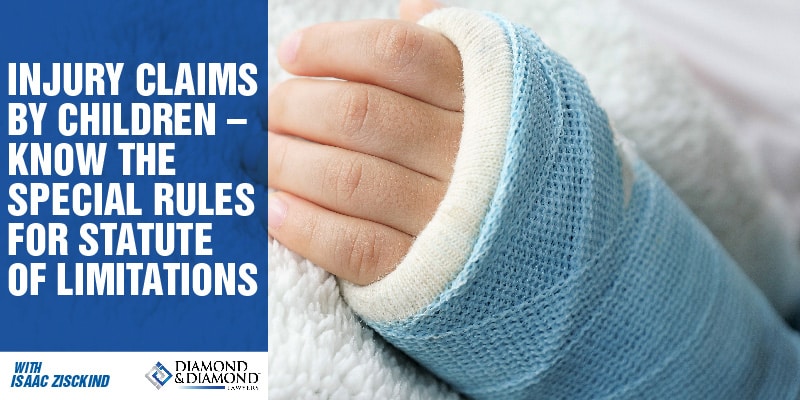- Our Firm
- Personal Injury
-
-
-
Personal Injury Lawyers
-
-
-
-
-
-
Injured in an accident? At Diamond & Diamond, our team of lawyers rely on their reputation in the field and extensive experience in personal injury to provide clients with a dedicated support system over the duration of their case.
-
-
-
-
-
HAVE YOU RECENTLY BEEN INJURED IN AN ACCIDENT?
-
-
-
- Corporate
- Class Action

Injury Claims By Children – Know The Special Rules For Statute of Limitations
#AskIsaacZisckind
The Ontario Limitations Act should be of a concern for anyone injury through the negligence of another party. Under normal circumstances, you only have two years from the date of the accident causing you to be injured to sue for compensation. Two years might appear to be a lot of time, but it can go by quickly. Waiting too long could ruin your chance to recover damages, but there are special rules in place to protect the rights of children and certain other categories of accident victims if a lawsuit is not filed within the two-year limitation period.
The purpose of limiting the time to sue
The law recognizes that claims for personal injuries, such as those suffered in a car accident, from a fall on a broken sidewalk or through the negligence of a surgeon performing an operation, could be difficult to defend against years after the event. Evidence could be lost or destroyed and witnesses might move away or forget important details about what they saw. For these reasons, the Ontario Limitations Act requires that you sue within two years from discovery of the claim.
It is important to note that the distinction between the date of discovery and the date of the accident or injury. Chances are that if you are injured in a car accident or due to a fall, the date of discovery will undoubtedly be the accident date.
Some types of claims, particularly those arising from a doctor’s negligence providing treatment to a patient, might not be as readily discoverable. For example, it could take months or years before symptoms develop from a surgical sponge left in a patient during an operation. The statute of limitations begins to run from the date on which a reasonable person faced with similar circumstances could be expected to discover the existence of a claim for damages.
Children and other exceptions to the statute of limitations
When a person injured through the fault of another party is younger than 18 years of age, the Limitations Act does not permit the limitation period to begin to run until a litigation guardian has been appointed for the child. Once a litigation guardian is appointed by a court, the limitation period begins to run.
The application to a court asking for appointment of a litigation guardian may be made by someone acting on behalf of the child. The law also permits a motion for appointment of a litigation guardian to be made by the defendant, the party against whom the child has a potential claim. The reason a potential defendant has the right to make the motion is to allow that party the opportunity to take action to prevent unnecessary delays.
Postponing the running of the limitation period also applies in situations in which the physical, mental or psychological condition prevents party with the right to make a claim for damages for personal injuries from doing so. As in the case of a minor with a claim for damages, the limitation period is suspended until a litigation guardian is appointed for the individual.
Ontario personal injury lawyers
The rules pertaining to limitation periods for suing for compensation for injuries caused through the negligence of another party are complex, so you should speak with a personal injury lawyer as soon after your injury as possible. The personal injury lawyers at Diamond and Diamond have years of experience successfully handling claims for compensation on behalf of accident victims throughout Ontario. Call the Diamond and Diamond 24/7 injury hotline at 1-800-567-HURT or visit our website to speak to someone now. We have offices located throughout Ontario offering free consultations and case evaluations to injury victims and their families.
Faqs
How does the date of discovery differ from the date of accident?
The date of discovery refers to the specific period when a person realizes the existence of adverse physical effects of past incidents or accidents. A suitable example would be someone realizing that his/her back condition is a direct consequence of years in heavy manual work. That particular day when a connection to an existing physical condition is made becomes the date of discovery.
On the other hand, the date of the accident is the precise date at which a person’s involvement in a singular incident or accident resulted in mild to severe physical injury. A suitable example is someone who experiences a herniated disk while lifting a product-laden crate at work. The particular day when the herniated disk injury occurred becomes the date of the accident.
What are the exceptions to the two-year statute of limitations for Ontario personal injury claims?
There are two main exemptions to the two-year statute of limitations on the filing of personal injury claims in Ontario. The first exemption revolves around the date of the discovery rule. This rule allows a person to file a personal injury claim for an act of negligence that occurred more than two years prior, as long as the date of discovery falls within the statutory two-year limit.
The second exemption revolves around realizing the litigation option in the pursuit of compensation for a personal injury. The provision allows an individual to file a personal injury lawsuit past the statutory two-year limit if he/she can prove to be unaware that litigation offered a venue to seek compensation for injuries caused by a negligent act.
Who can be eligible to be appointed as the litigation guardian?
A litigation guardian has the role of a substitute decision-maker in legal proceedings involving a legally disabled plaintiff. A legally disabled individual in this context refers to someone with a reduced ability to grasp the legal specifics of the case, e.g., a child, a person with low cognitive capability, and so forth.
Anyone who files a written consent from the legally disable plaintiff is eligible for a litigation guardian’s role. A judge can also appoint any person he/she deems as qualified to take up a litigation guardian’s role.
Need a Lawyer?
We are here 24/7 to address your case. You can speak with a lawyer to request a consultation.
1-800-567-HURTGet started with a free consultation
OUR TEAM
- Yefim Belyavsky
- Osama Hashmi
- Nicole Sherman
- Quan Duong
- Sheffali Chaudhary
- Francesco Rotatore
- Samarth Bajaj
- Qasim Latif
- Jeffrey Stephan
- Cassandra Harvey
- Ishmeet Sandhu
- Nolan Bachmann
- Annamarie Demaj
- Jeffrey Hum
- Tofunmi Adeyeye
- Alessia De Gasperis
- Amandeep Chawla
- Jeremy Tsoi
- Kimiya Razin
- Shir Zisckind
- Gray Sinden
- Shelly Bard
- Christian Brown
- Daly Canie
- Tanveer Sohal
- Prianka Virdi
- Noah Brownstone
- Justin Kaminker
- Harinder S. Bhatti
- Craig Yargeau
- Kiran Birk
- Amit Singh
- Andrei Teju
- Maria Zahid
- Jacob Elyk
- Harry Gill
- Kristina Olivo
- Egi Bano
- Cam Woolley
- Charles Thompson
- Alexandra McCallum
- John Sime
- Allan Cocunato
- Patrick Poupore
- Erika Henderson
- Marina Korshunova
- Brandon Handelman
- Regeena Alapat
- Ryna Kim
- Isaac Zisckind
- Manpreet Bhogal
- Mathura Santhirasegaram
- Nikolai Singh
- Sandra Zisckind
- Jeremy Diamond
- Michael Blois
- Darryl Singer
- Nadia Condotta
- Tinashe Madzingo
- Veronica D’Angelo
- Corey J. Sax
- Scott Tottle
- Steven Wilder
- TJ Gogna
- Jillian Carrington
- Joshua Himel
- Simon Diamond
- Cory Rubin
- Simon Mariani
- Brandon Greenwood
- Basil Bansal
- Nastassia Ivanova
- Tania Fleming
- George Laloshi
- Patrycja Majchrowicz
- Diana Iakossavas
- Dior Africa
- Alex Ragozzino
- Liana Saccucci
- Richard J. Chang
Head Offices
Main Offices
Barrie
Main Office
168 Bayfield Street
Calgary
Main Office
1331 Macleod Trail SE, Suite 645
Edmonton
Head Office
4246 97 Street NW, Unit 103
Halifax
Consultation Office
1701 Hollis St
London
Main Office
256 Pall Mall St, Suite 102
Oshawa
Consultation Office
50 Richmond Street E, Unit # 108 B
Ottawa
Main Office
955 Green Valley Crescent, Unit 315
Sudbury
Main Office
31 Larch Street, Unit 300
Timmins
Main Office
120 Cedar Street South, Unit 002A
Toronto
Head Office
255 Consumers Road, 5th Floor
Vancouver
Head Office
1727 West Broadway, Suite 400
Windsor
Main Office
13158 Tecumseh Rd. E. Unit 3B
Additional Areas Served
Ontario
- Ajax
- Alberta
- Aurora
- Barrie
- Belleville
- Bowmanville
- Brampton
- Brantford
- Brockville
- Bracebridge
- Bradford
- Burlington
- Burnaby
- Calgary
- Chatham
- Cobourg
- Collingwood
- Cornwall
- Durham
- Edmonton
- Elliot Lake
- Etobicoke
- Georgetown
- Guelph
- Hamilton
- Huntsville
- Kanata
- Kelowna
- Kingston
- Kitchener
- Leamington
- London
- Markham
- Milton
- Mississauga
- Muskoka
- Niagara Falls
- Newcastle
- Newmarket
- North Bay
- North York
- Oakville
- Orangeville
- Orillia
- Oshawa
- Ottawa
- Owen Sound
- Parry Sound
- Perth
- Peterborough
- Pickering
- Prince Edward County
- Richmond
- Richmond Hill
- Sault Ste Marie
- Sarnia
- Scarborough
- St. Catharines
- St. Thomas
- Stouffville
- Sudbury
- Surrey
- Thunder Bay
- Timmins
- Toronto
- Uxbridge
- Vancouver
- Wallaceburg
- Waterloo
- Welland
- Whitby
- Windsor
- Woodstock













